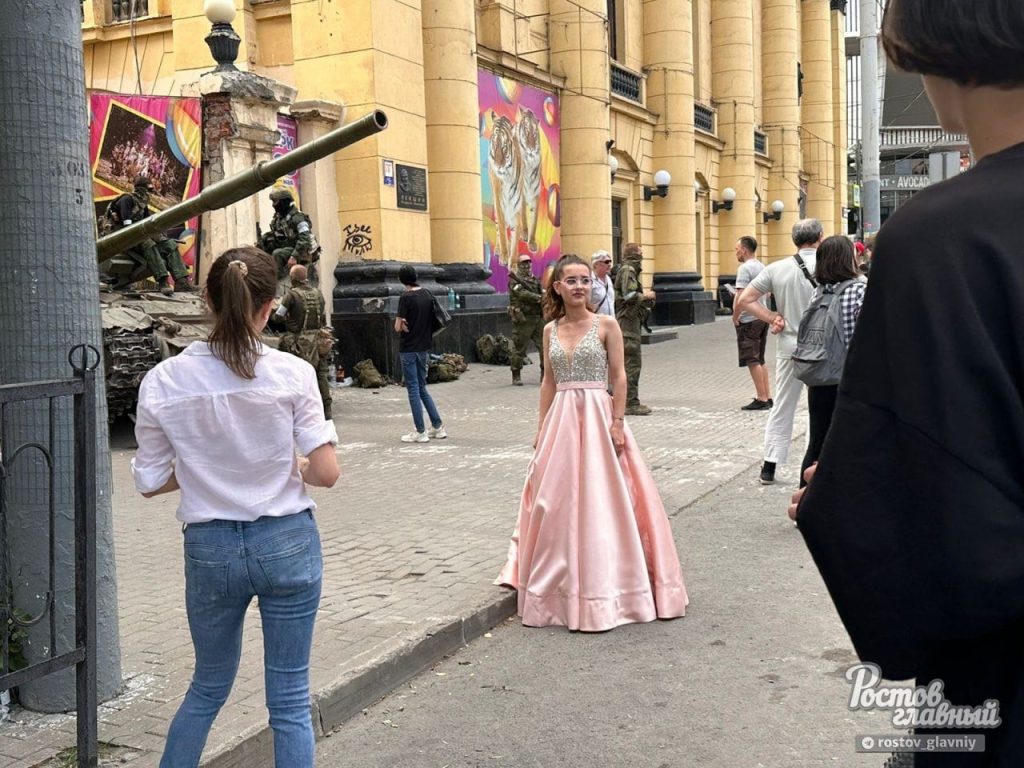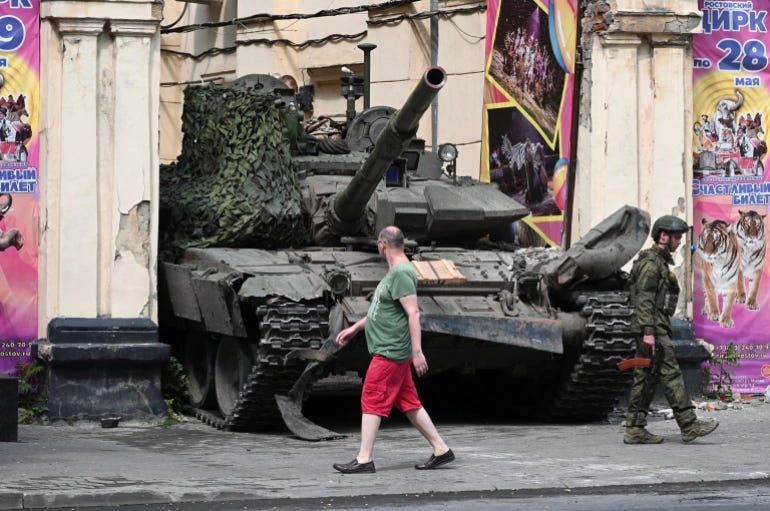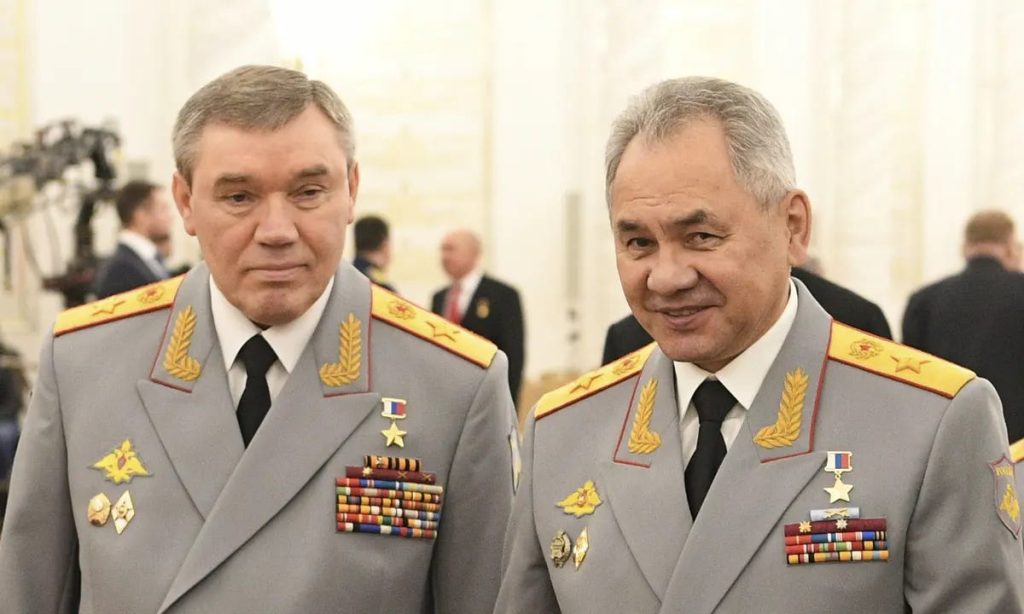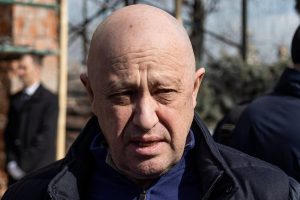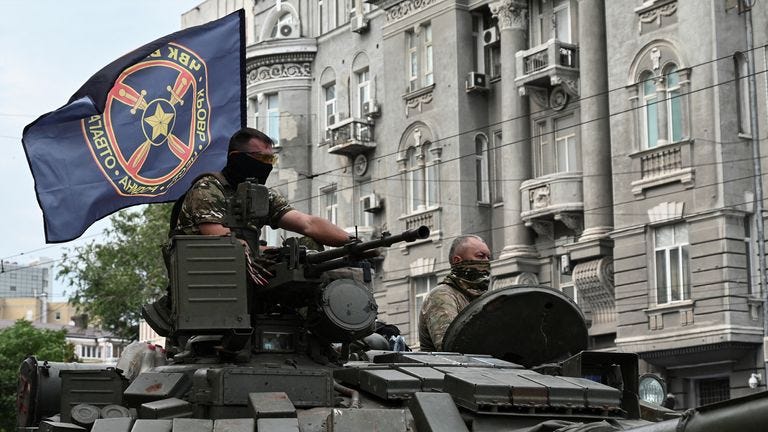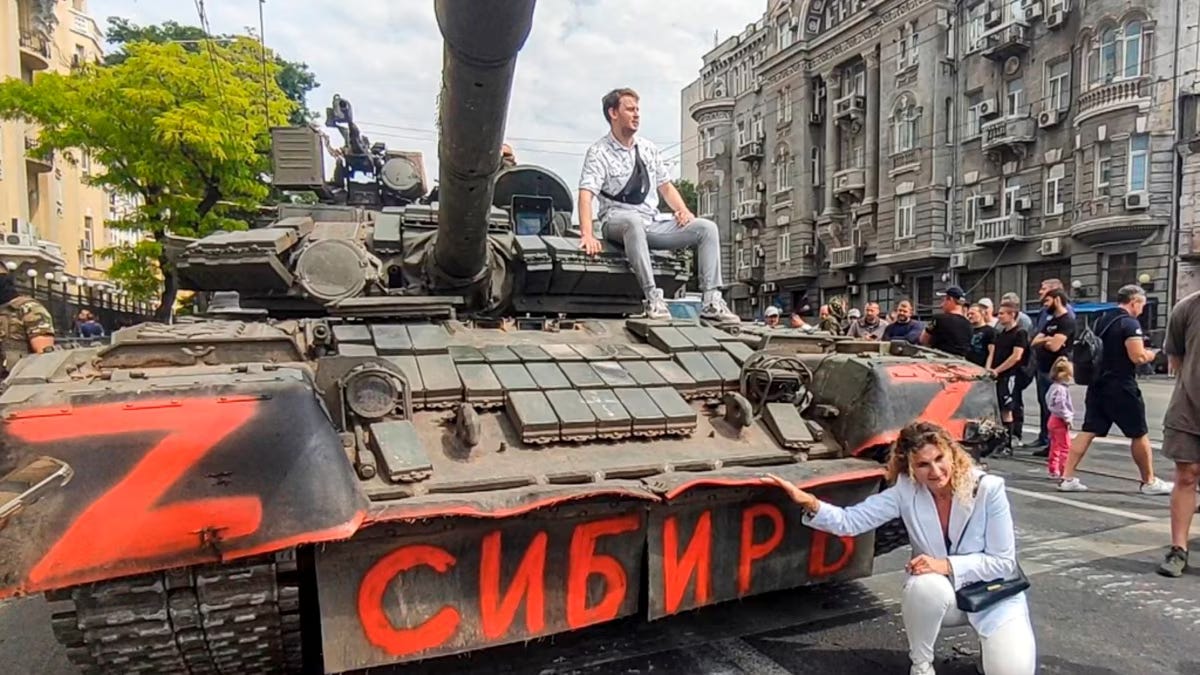Russo-Ukrainian War: The Wagner Uprising
Yevgeny Prigozhin's Wild Ride
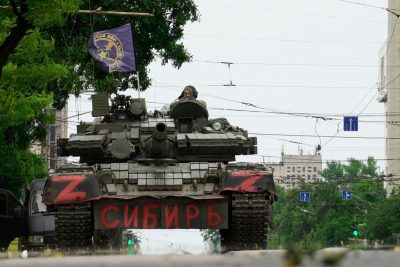
All Global Research articles can be read in 51 languages by activating the Translate Website button below the author’s name.
To receive Global Research’s Daily Newsletter (selected articles), click here.
Click the share button above to email/forward this article to your friends and colleagues. Follow us on Instagram and Twitter and subscribe to our Telegram Channel. Feel free to repost and share widely Global Research articles.
***
The events of the past weekend (June 23 – 25, 2023) were so surreal and phantasmagorical that they militate against narration and defy description.
On Friday, the infamous Wagner Group launched what appeared to be a genuine armed insurrection against the Russian state. They occupied portions of Rostov on Don – a city of over 1 million people, regional capital, and headquarters of Russia’s Southern Military District – before setting off in an armed column towards Moscow.
This column – replete with heavy military equipment including air defense systems – came within a few hundred miles of the capital – virtually unmolested by Russian state forces – before abruptly stopping, announcing that a deal had been brokered with the aid of Belarusian President Aleksandr “Uncle Sasha” Lukashenko, turning around, and heading back to Wagner bases in the Ukrainian theater.
Needless to say, the spectacle of a Russian mercenary group making an armed march on Moscow, and of Wagner tanks and infantry cordoning off Ministry of Defense buildings in Rostov, sparked widespread confidence among the western commentariat that the Russian state was about to be toppled and the Russian war effort in Ukraine would evaporate.
There were confident and outlandish predictions pushed out in a matter of hours, including claims that Russia’s global footprint would disintegrate as the Kremlin recalled troops to defend Moscow and that Russia was about to enter a state of Civil War. We also saw the Ukrainian propaganda machine kick into overdrive, with characters like Anton Gerashchenko and Igor Sushko absolutely bombarding social media with fake stories about Russian army units mutinying and regional governors “defecting” to Prigozhin.
There’s something to be said here about the analytic model that prevails in our time – there’s a machine that instantly springs to life, taking in rumors and partial information in an environment of extreme uncertainty and spitting out formulaic results that match ideological presuppositions. Information is not evaluated neutrally, but forced through a cognitive filter that assigns it meaning in light of predetermined conclusions. Russia is *supposed* to collapse and undergo regime change (Fukuyama said so) – therefore, Prigozhin’s actions had to be framed in reference to this assumed endgame.
On the opposite end of the spectrum, we saw some similar measure of aggressive model-fitting from “Trust the Plan” Russia supporters, who were confident that the Wagner uprising was just an act – an elaborate ruse concocted in concert by Prigozhin and Putin to fool Russia’s enemies and advance the plan. The analytic error here is the same – information is parsed only for the purpose of buttressing and advancing a pre-concluded endgame; except it is Russian omnicompetence which is assumed instead of Russian state collapse.
I took something of a middle view. I found the idea that Russia faced civil war or state collapse to be bizarre in the extreme and completely unfounded, but I also did not think (and I feel that events have vindicated this view) that Prigozhin was acting in collaboration with the Russian state to create a charade. If indeed the Wagner uprising was a Psyop (Psychological Operation) to trick NATO, it was an extremely elaborate and convoluted one which hasn’t yet shown any clear benefits (more on this in a moment).
My broad belief is that Prigozhin was acting of his own volition in an extremely risky way (which risked both his own life and a destabilizing effect on Russia). This presented the Russian state with a genuine crisis (albeit one which was not sufficiently severe to threaten the state’s existence) which I think they handled quite well on the whole. The Wagner uprising was quite clearly bad for Russia, but not existentially so, and the state did a good job containing and mitigating it.
Let’s get into it, starting with a short look at the timeline of events.
Anatomy of a Mutiny
The amount of disinformation (particularly propagated by the Ukrainians and by Russian liberals residing in the west) that flew around throughout the weekend was extreme, so it might be prudent to review the progression of events as they actually happened.
The first sign that something was amiss came with a few explosive statements by Wagner head Yevgeny Prigozhin on the 23rd (Friday). In a rather long and erratic interview, he made the shocking claim that Russia’s pretext for the war in Ukraine was an outright lie and that the war had been fraught with corruption and the murder of civilians.
Things then got even crazier when Wagner claimed that the Russian army had struck their camp with a missile. This was extremely weird – the video which was released (purporting to show the aftermath of this “missile strike”) did not show an impact crater, debris, or any wounded or killed Wagner personnel. The “damage” from the missile consisted of two campfires burning in a trench – apparently Russia has missiles that can start small controlled fires without destroying the surrounding plant life?
The video obviously did not show the aftermath of a missile attack, but Prigozhin’s rhetoric escalated after this and he soon announced that Wagner would begin a “march for justice” to gain redress for his various grievances.
It was not clear exactly what he wanted, but it seemed to center on personal grudges against Minister of Defense Sergei Shoigu and Chief of the General Staff Valery Gerasimov.
Shortly thereafter, a few videos came from the Russian authorities (including one featuring General Surovikin) apparently pleading with Wagner to “stop the movement of their columns” and return to their posts, to prevent bloodshed and destabilization. This validated some of the rumors that Wagner was leaving the theater in force. News that Russian National Guard had been activated in Moscow and elsewhere seemed to vindicate the fear that an armed clash in Russia was imminent.
By the end of Friday, armed Wagner convoys were in Rostov (bearing the red Z mark) and had taken control of several military offices in what amounted to a bloodless coup of the city. The scenes were a bit outlandish – tanks on the city streets and security cordons around key facilities, but seeming indifference from the population. People mingled among the Wagner troopers, street sweepers went about their work, Wagner bought cheeseburgers, and people took pictures with the tanks.
A T-72 is the ultimate accessory
That evening, Prigozhin had a tense but civil face to face meeting with two high level MOD officials – Yanus Evkurov (Deputy Defense Minister) and Vladimir Alekseev (Deputy Head of the military intelligence directorate).
Things really got heated the next day (Saturday the 24th) with the news that two substantial armed bodies were on the move within the prewar Russian borders.
One was a column of Wagner personnel and weapons who left Rostov for Moscow, and other was a Chechen force dispatched by the state to Rostov.
Amid the news that Russian state forces were establishing roadblocks and defensive positions outside of Moscow, it looked like two separate battles might have been imminent – one by the Wagner column fighting state forces outside Moscow, and another fought between the Chechens and the Wagner remnants for control of Rostov.
It was at this point that Ukrainian disinformation really began to run wild, with claims flying around that Russian military units and regional administrations were defecting to Prigozhin – in effect positing that this was not just an uprising by Wagner against the state, but a wholesale revolt of the Russian system against Putin’s government. In fact (and this is a key point to which I will return later) there were no defections in any regular Russian military units or regional governments and there was no civil unrest. The mutiny was confined to the Wagner Group, and even so not all of Wagner participated.
Be that as it may, by the early evening hours on Saturday there were real reasons to worry that shooting might start outside Moscow or in Rostov. Putin issued a statement denouncing treason and promising an appropriate response.
The Russian Ministry of Justice opened a criminal file on Prigozhin for treason. Two Russian MoD aircraft were shot down (an Mi-8 helicopter and an IL-22) by the Wagner column. The global atmosphere became notably more humid from the volume of salivation flowing from Washington.
Can’t park there, buddy
Then, the Wagner column stopped. The government of Belarus announced that a settlement had been negotiated with Prigozhin and Putin. Lukahsenko’s office claimed “they came to agreements on the inadmissibility of unleashing a bloody massacre on the territory of Russia.” The column turned aside from the road to Moscow and returned to Wagner’s field camps around Ukraine, and the Wagner forces left in Rostov packed up and left. Aside from the crews of the two downed aircraft, nobody was killed.
Of course, speculation immediately turned to the terms of the deal between Prigozhin and the state. Some speculated that Putin had agreed to remove Shoigu, Gerasimov, or both from their posts (perhaps this was the point all along?). In fact, the terms were relatively lame and anticlimactic:
- The treason case against Prigozhin was dropped and he was to go to Belarus
- Wagner fighters who participated in the uprising would not be charged and would return to operations in Ukraine
- Wagner fighters that did not participate in the uprising would sign contracts with the Russian military (essentially exiting Wagner and become regular contract troops)
- A vague reference to “security guarantees” for Wagner fighters
So, this is all very weird. A genuine armed insurrection with tanks and heavy weapons (not a man in a buffalo headdress) with a takeover of military facilities brought to a sudden resolution by Lukashenko, and all that Prigozhin seems to have gotten out of it was… free passage to Belarus? Odd indeed.
So let’s try to parse through what happened here using an analytical framework that is not pre-deterministic – that is, let us assume that neither Russian omnicompetence nor Russian regime change and neoliberal cuddliness are guaranteed.
I’d like to start by addressing precisely these two ideologically predetermined theories. On one side we had those claiming that Russia was about to be plunged into civil conflict and regime change, and on the other those who think the whole thing was a pre-planned psyop by the Russian government. The former have already been discredited by virtue of the fact that all their dramatic predictions collapsed in 24 hours – Prigozhin did not, in fact, lead a metastasizing mutiny, overthrow Putin, and declare himself Tsar Eugene I. The other extreme theory – the psyop – remains viable, but I think extremely unlikely, for reasons I will enumerate now.
Psyop Scenarios
It’s relatively easy to simply say “the mutiny was a psyop” without elaborating. It’s trivially obvious that the Wagner uprising “fooled” western analysis – but this isn’t ipso facto evidence that the uprising was staged for the purpose of fooling the west. We have to ask for something more specific – to what end might the uprising have been scripted?
I’ve identified what I think are four discreet theories that at least merit examination – let’s take a look at them and talk about why I think they all ultimately fail to explain the uprising to satisfaction.
Option 1: Live Bait
One potential explanation – which I have seen suggested quite frequently – is the idea that Prigozhin and Putin staged the uprising for the purpose of drawing out theoretical networks of seditionists, foreign agents, and disloyal elements. I suppose the thinking was that Prigozhin would create a controlled, but cosmetically realistic sense of crisis for the Russian state, making Putin’s government appear vulnerable and coercing treacherous and enemy parties across Russia into revealing themselves.
Conceptually, this amounts to little more than Putin’s government pretending to be a wounded animal for the purpose of drawing out the scavengers so they can be killed.
I think this theory has appeal to people because it posits Putin as an extremely crafty, Machiavellian, and paranoid leader. This is also why I think it’s wrong. Putin has derived a great deal of legitimacy from his ability to fight the war without disrupting day to day life in Russia – there’s no rationing, no conscriptions, no restrictions on movement, etc. In fact, one of the biggest criticisms of Putin has been from the war party, who allege that he’s fighting the war too timidly for fear and is too preoccupied with maintaining normalcy in Russia.
It seems incongruous, then, that a leader who has taken great care to avoid putting Russian society on a war footing would then do something as destabilizing as staging a fake uprising. Furthermore, if indeed the Wagner revolt was a charade to smoke out other treacherous and terroristic elements, it failed badly – there were no defections, no civil unrest, and no denunciations of Putin. So for several reasons, the live bait theory does not pass the sniff test.
Option 2: Masking Deployments
A second theory is the idea that the Wagner uprising was essentially a giant smokescreen to enable the movement of military forces around Russia. I suppose the thinking here is that if armed columns are seemingly flying around wildly, people might not notice if Russian forces moved into position to, say, attack Sumy or Kharkov. This take was cosmetically bolstered by the news that Prigozhin would be going to Belarus. Was this entire thing a ruse to mask the redeployment of Wagner for an operation in Western Ukraine?
The problem with this line of thinking is three fold. First, it misunderstands the complexity of staging a force for operations. It’s not just about driving a line of trucks and tanks into position – there are enormous logistical needs. Ammo, fuel, rear area infrastructure all need to be staged. This can’t be done in 24 hours under the temporary cover of a fake mutiny.
Secondly, the “distraction” effect is mostly directed at media and the commentariat, not at military intelligence. Put another way – CNN and the New York Times were definitely fixated on the Wagner uprising, but American satellites continue to pass over the battlespace and western ISR is still functioning. Prigozhin’s antics would not stop them from observing staging to attack a new front.
Third and finally, it doesn’t appear that much of Wagner will be accompanying Prigozhin to Belarus – his journey to Lukashenko Land looks more like an exile than a redeployment of the Wagner Group.
Option 3: Engineered Radicalization
This is the usual “false flag” sort of theory that circulates any time anything bad happens anywhere. It’s become rather blasé and trite: “Putin staged the uprising so he could escalate the war, increase mobilization, etc.”
This doesn’t make any sense and is pretty easy to dismiss. There have been real Ukrainian attacks inside Russia (including a drone attack on the Kremlin and cross-border forays by Ukrainian forces). If Putin wanted to intensify the war, he could have used any of these opportunities. The idea that he would choose to orchestrate an internal uprising – running the risk of widespread destabilization – rather than focusing on Ukraine is ridiculous.
Option 4: Consolidation of Power
Of all the psyop theories, this is the one that probably has the most merit. There were two different strains to this, which we’ll treat in turn.
At the beginning, some speculated that Putin was using Prigozhin to create a pretext to force out Shoigu and Gerasimov. I thought this was unlikely for a few reasons.
First, I don’t think there is a valid case to be made that these men deserve to be fired. There were uneven elements of Russia’s war in the beginning, but there is a clear arc of improvement in the armaments industry with key systems like the Lancet and Geran becoming available in ever increasing quantities, and right now the Russian armed forces are making mulch out of Ukraine’s counteroffensive.
Secondly, if Putin wanted to remove either Shoigu or Gerasimov, doing so in response to a faux-uprising is the worst way to do it, because this would give the appearance of Putin bowing to the demands of a terrorist. Keep in mind, Putin has not publicly criticized either Shoigu or Gerasimov for their handling of the war. Publicly, they appear to have his full backing. Could the president really remove them in response to Prigozhin’s demands without appearing incredibly weak? Far better if Putin simply fired them of his own volition – making himself, and not Prigozhin, the kingmaker.
Sure enough, it does not appear at this point that either Shoigu or Gerasimov will lose their posts. This led the “power consolidation” theory to pivot to a second line of thinking, that Putin wanted to use Prigozhin to essentially stress-test the Russian political system by seeing how regional administration and army leadership would respond.
The objects of Prigozhin’s wrath?
This treats the uprising like a fire drill – turn on the alarm, and see how everyone responds, and take notes on who followed instructions. To be sure, Russian political figures came crawling out of the woodwork to affirm their support for Putin and denounce Wagner – complete with some trademark Russian flair, like the Governor of Tver calling on Prigozhin to commit suicide. This perhaps lends credibility to the idea that Putin wanted to test his subordinates.
Again, however, I think this theory misses a few key points. First off, Russia appeared to be internally very stable. Putin was facing no opposition or pushback, no civil unrest, no mutinies in the army, no criticism from high profile political figures – it’s not clear why he would feel the need to rock the country just to test the loyalty of the political apparatus. Perhaps you think he’s a hyper-paranoid Stalin figure who feels driven to play mind games with the country, but this really does not square with his operating pattern. Secondly, the trajectory of the war is overwhelmingly in Russia’s favor at the moment, with victory at Bakhmut fresh in the public memory and Ukraine’s counteroffensive looking more and more like a world historical military bust. It makes little sense why at this time in particular, when things are going very well for Russia, Putin would want to drop a grenade just to test reaction times.
Ultimately, I think that all of these “Psyop” theories are very weak when evaluated in good faith in their own terms. Their errors share a common thread. Things have been going very well for Russia, with the army performing excellently in the ongoing defeat of the Ukrainian counteroffensive, no internal disorder or unrest, and a growing economy. The psyop line of thought presumes that, in a time where things are going well, Putin would take an enormous risk by staging a fake mutiny for negligible gains, risking not only civil unrest and bloodshed but also marring Russia’s image of stability and dependability abroad.
The presumption is that the Putin team is omnicompetent and is able to game out a highly complex deception scheme. I don’t think the Russian government is omnicompetent. I think they are simply a normal level of competent – too competent to pull a high risk, low reward stunt like this.
What Prigozhin Wants
I sometimes like to think of western “end of history” predeterminism (in which all of history is an inexorable march towards global neoliberal performative democracy and the final liberation and happiness of all mankind is announced when the victorious pride flag flies in Moscow, Beijing, Tehran, and Pyongyang) as being essentially a geopolitical corollary to Jurassic Park – a poignant story of hubris and ruin (and one of my favorite movies).
The analytic model of Jurassic Park’s creators presumed that the dinosaurs – creatures about whom they knew practically nothing – would over time submit to control routines like zoo animals. Blinded by the illusion of control and the theoretical stability of their systems (presumed to be stable because it was designed to be stable), there was no appreciation for the fact that the Tyrannosaurus had an intelligence and a will of its own.
I think that Yevgeny Prigozhin is a bit like the Tyrannosaurus in Jurassic Park. Both the western neoliberal apparatus and the Russian four dimensional plan-trusters seem to think of Prigozhin as a cog that exists to execute the function of their world model. Whether that model is the long march of history towards democracy and the last man or a brilliant and nuanced master plan by Putin to destroy the unipolar Atlantic world, it does not matter much – both tend to negate Prigozhin’s agency and turn him into a slave of the model. But perhaps he is a Tyranosaurus, with an intelligence and will that has an internally generated direction indifferent to our world models. Perhaps he tore down the fence for reasons of his own.
Image: A would-be Lenin? Or just a man with his back at the wall?
We have to return to who Prigozhin is, and what Wagner is.
To Prigozhin, Wagner is first and foremost a business which has made him a huge amount of money, particularly in Africa. Wagner’s value (in the most fundamental sense) comes from its high degree of combat effectiveness and its unique status as an independent entity from the Russian armed forces. Any threat to either of these factors represents a financial and status catastrophe for Prigozhin.
Recently, developments in the war have evinced an existential threat to the Wagner group as a viable PMC. These are, namely:
- A concerted push by the Russian government to force Wagner fighters to sign contracts with the Ministry of Defense. In effect, this threatens to liquidate Wagner as an independent organization and subsume it wholesale into the regular Russian military.
- Wagner is losing the manpower surge from last year’s conscriptions (including convicts). These conscripts provided an enormous manpower buffer that allowed Wagner to shoulder the large-scale fighting in Bakhmut, but many have completed their tours of duty.
This means that Wagner faces potential destruction from two fronts. Institutionally, the Russian government wants to essentially neutralize Wagner’s independence by folding it into the MoD. From Prigozhin’s point of view, this essentially means the nationalization of his business.
Furthermore, a slimmed down Wagner (having shed much of the conscripts that fleshed it out to Army Corps size) is not something that Prigozhin wants to send into combat in Ukraine. Once Wagner is stripped down to its core of experienced wet work operators, casualties in Ukraine will begin eating directly into Wagner’s viability.
In other words, Prigozhin and the authorities were at an impasse. What Prigozhin probably wanted most of all, to put it bluntly, was to use the fame won in Bakhmut to take Wagner back to Africa and start making lots of money again. What he did not want was to have his PMC absorbed into the Russian military, or to have his core of lethal professionals attrited in another major battle in Ukraine. The MoD, on the other hand, very much wants to absorb Wagner fighters into the regular army and use them to defeat Ukraine on the battlefield.
So, we have a clear conflict of interests.
But what can Prigozhin do about it? He has absolutely no institutional power, and Wagner is dependent on the Ministry of Defense for equipment, supplies, ISR, and so much more. Furthermore, Prigozhin’s personal wealth and his family are under the jurisdiction of the Russian state. He has very limited leverage. There are really only a few things he can do. He can record videos to embarrass, harass, and degrade the Ministry of Defense. Of course, it’s probably unwise to directly attack Putin in these rants, and it might not play well to insult ordinary Russian soldiers, so these attacks have to be properly targeted at precisely the sort of bureaucratic higher ups that the Russian public is predisposed to dislike – men like Shoigu and Gerasimov.
Apart from these video tantrums, Prigozhin really had only one other play to stop the institutional absorption of Wagner – stage an armed protest. Get as many men as he could to join him, make a move, and see if the state could be rocked enough to give him the deal he wanted.
It sounds weird, of course. You’ve heard of gunboat diplomacy – now we get to see tank-based contract negotiations. Yet it is clear that the dispute over Wagner’s independence and status vis a vis Russian military institutions was at the heart of this. Earlier this month, Prigozhin announced his intention to disobey a presidential order that required his fighters to sign MoD contracts by July 1.
Prigozhin’s statement this morning (Monday, June 26), however, was extremely instructive. It focused almost exclusively on his central grievance: Wagner was going to be absorbed into the institutional military. He doesn’t take this to its conclusion and note that this would nationalize his highly profitable business, but his comments leave no doubt as to his motivation. Here are a few key points that he makes:
- Wagner did not want to sign contracts with the Ministry of Defense
- Absorption into the MoD would mean the end of Wagner: “This unit was supposed to cease its existence on July 1.”
- “The goal of our campaign was to prevent the destruction of Wagner Group.”
But what did Prigozhin think would happen? What was his optimistic scenario? Likely, he hoped that general anti-bureaucratic and anti-corruption sentiments, combined with Wagner’s popularity and fame, would lead to an upswell of support for the group which would put the government in a position to acquiesce to Wagner’s independence.
It was a bold decision. Facing institutional absorption, Prigozhin gambled on a measured destabilization campaign that would rock the country just enough to spook Putin into cutting him a deal. Prigozhin might have convinced himself that this was a clever and decisive roll of the dice that could turn things in his favor. I rather think that they were not playing dice at all. They were playing cards, and Prigozhin had nothing in his hand.
Russia’s Crisis Management
This is the part of the article that I suspect will ruffle feathers and earn me accusations of “coping” – so be it. Let’s just get this out in the open:
Russia handled the Wagner uprising extremely well, and its management of the crisis points to a high degree of state stability.
Now, what I am not saying is that the uprising was good for Russia. It was clearly a net-negative in several ways. Russian aircraft were shot down by Wagner and Russian pilots were killed. Prigozhin was then allowed to walk away after causing these deaths – a stain on the government. There was widespread confusion which does nothing good for morale, and operations in the Southern Military District were disrupted by Wagner’s occupation of Rostov.
On the whole, this was not a good weekend for Russia. It was a crisis, but it was a crisis that the state handled quite well overall and mitigated the downsides – perhaps even making a glass or two of lemonade out of Prigozhin’s lemons. It’s a bit fitting, perhaps, that Shoigu used to be Minister of Emergency Situations (essentially disaster relief). Disasters are never good, but it’s always better to handle them well when they happen.
The state response was actually pretty straightforward: call Prigozhin’s bluff.
Prigozhin drove toward Moscow with his column – but what was he going to do if he got there? Russian national guard was preparing to block them from entering the city. Would Wagner attack Moscow? Would they shoot national guardsmen? Would they assault the Kremlin or shell Saint Basil’s? Doing so would lead to the inevitable death of every man involved. Wagner, with no supply or procurement of its own, cannot fight the Russian armed forces successfully and probably could not supply itself for more than a day or two.
The problem with Prigozhin’s approach is that pantomiming a coup doesn’t work if you aren’t willing to actually attempt a coup – and a coup only works if institutional authorities side with you. It’s not as if Prigozhin could drive a tank up to Lenin’s mausoleum and begin issuing orders to the federal ministries and armed forces. Coups require control over institutional levers of power – regional governorships, government ministries, and the officer corps of the armed forces.
Prigozhin not only lacked all of these things, but in fact the entire apparatus of power denounced him, scorned him, and branded him a traitor. Having mutinied his way into a dead end, his only choices were to either start a firefight outside Moscow and guarantee that he would die and be known to history as a traitorous terrorist, or to surrender. It is probable that the Wagner column shooting down Russian aircraft (which Prigozhin later claimed was a “mistake”) spooked him and confirmed that he was going too far and did not have a good way out. When your opponent calls and you have nothing in your hand, there is nothing to do except fold.
Consider then, for a moment, the actual scene in Russia. An armored column was driving towards the capital. What was the response from the Russian state and people? Authorities at all levels publicly denounced the uprising and stated support for the president. There were no defections, either from military units or civilian administration. There was no civil unrest, no looting, no loss of even basic government control in the country. Compare the scenes in Russia during an armed rebellion to the United States in the summer of 2020. Which country is more stable, again?
In the end, the government managed to dissipate a crisis situation, which could easily have spiraled into substantial bloodshed, without any loss of life apart from the crews of the two downed aircraft (deaths that we should not minimize, and must be remembered as victims of Prigozhin’s ambition).
Furthermore, the terms of the “settlement” amount to little more than surrender by Prigozhin. He himself seems to be bound for a sort of semi-exile in Belarus (potentially awaiting a Trotsky ice-pick moment) and it seems that the majority of Wagner will sign contracts and be absorbed into the Russia institutional military. Based on the speech that Putin gave this evening (fifteen minutes ago as of this writing), Wagner fighters have only three options: sign MOD contracts, disband and go home, or join Prigozhin in Belarusian exile (presumably without their gear). As it relates to the institutional status of Wagner, Prigozhin lost and the state won. Wagner as an independent fighting body is finished.
We must be honest, of course, about the damages of the uprising.
Prigozhin killed Russian servicemembers when his column downed those aircraft, and then had his treason charge dropped. One can say, of course, that bringing a peaceful resolution prevented further bloodshed, but this doesn’t change the fact that he killed Russian soldiers and gets to walk away. This is a failure with both a moral and an institutional legitimacy dimension.
Additionally, this entire episode ought to serve as a poignant lesson about the inherent instability of relying on mercenary groups who operate outside of formal military institutions. There are many such groups in Russia, not just Wagner, and it will be malpractice if the government does not move decisively to liquidate their independence. Otherwise, they are simply waiting for something like this to happen again – potentially with a far more explosive outcome.
On the whole, however, it seems rather undeniable that the government handled an extreme crisis rather competently. Contrary to the new western spin that the Wagner revolt revealed the weakness of Putin’s government, the unity of the state, the calmness of the people, and the coolheaded strategy of de-escalation suggest that the Russian state is stable.
Conclusion: 1917
One of humanity’s most universal and beloved pastimes is making bad historical analogies, and that process was certainly in high gear this past weekend. The most popular comparison, naturally, was to compare Prigozhin’s uprising to the fall of the Tsar in 1917.
The problem is that this analogy is a perfect inversion of the truth.
The Tsar fell in 1917 because he was at army headquarters far away from the capital. In his absence, a garrison mutiny in Petrograd (Petersburg) led to a collapse of government authority, which was then picked up by a new cabinet formed from the state Duma. Coups are not achieved through mindless bloodshed. What matters most is the basic question of bureaucratic authority, for this is what it means to rule. When you pick up a phone and give an order to shut down a rail line; when you summon a military unit to readiness; when you issue a purchasing order for food or shells or medicine – are these instructions respected?
It was trivially obvious that Prigozhin lacked either the force, the institutional support, or any real desire to usurp authority, and the idea that he was attempting a genuine coup was absurd. Imagine, for a moment, that Wagner managed to bash its way through the Russian National Guard into Moscow. Prigozhin storms the ministry of defense – he arrests Shoigu and sits in his chair. Do we really believe that the army in the field would suddenly follow his orders? It’s not a magic chair. Power only comes up for grabs in the event of total state collapse, and what we saw in Russia was the opposite – we saw the state closing ranks.
So in the end, both the neoliberal commentariat and the Russian plan trusters are left with an unsatisfactory view of events. Prigozhin is neither the harbinger of regime change nor a piece in Putin’s four dimensional chess game. He’s simply a mercurial and wildly irresponsible man who saw that his Private Military Corporation was going to be taken away from him and decided to go to extreme and criminal lengths to prevent this. He was a card player with nothing in his hand who decided to bluff his way out of a corner – until his bluff was called.
*
Note to readers: Please click the share button above. Follow us on Instagram and Twitter and subscribe to our Telegram Channel. Feel free to repost and share widely Global Research articles.
All images in this article are from the author


